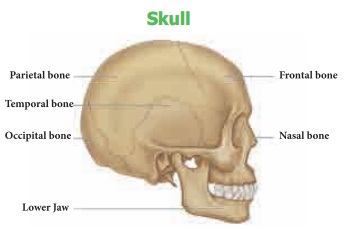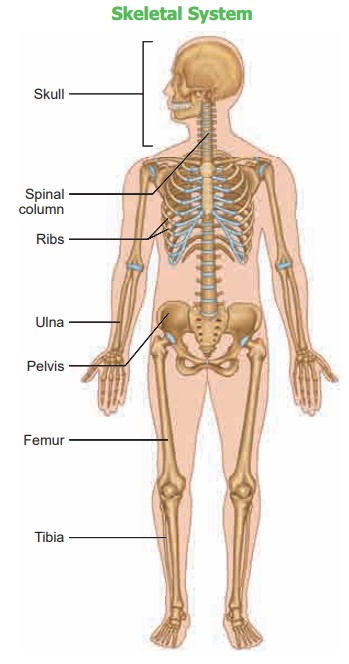Human Organ systems | Term 2 Unit 6 | 6th Science - Skeletal System | 6th Science : Term 2 Unit 6 : Human Organ systems
Chapter: 6th Science : Term 2 Unit 6 : Human Organ systems
Skeletal System
Skeletal System
The skeletal system consists of bones,
cartilages and joints. Bones provide a frame work for the body. Bones along
with muscles help in movements such as walking, running, chewing and dancing
etc.,
The adult human skeletal system consists of 206
bones and few cartilages, ligaments and tendons. Ligaments help in connecting
bone to bone. Tendons connect bone to muscle. The two major divisions of the
skeletal system are Axial skeleton and Appendicular skeleton.
Axial skeleton
forms the upright axis of the body which includes
* Skull
* Vertebral column
* Rib cage
Appendicular
skeleton consist of the bones of the limbs along with their pectoral and pelvic
girdles.
Activity 1: Sit absolutely still. Observe the
movements taking place in your body. You must be blinking your eyes time to
time. Observe the movements in your body as you breathe. Write down the
movements in your note book.
We
are able to move a few parts of our body easily in various directions and some,
only in one direction. Why we are not able to move some parts at all
directions?
Skull
The skull is made up of cranial bones and
facial bones. It protects the brain and the structures of the face. The hyoid
bone present at the base of the buccal cavity and the auditory ossicles
(Malleus, Incus and Stapes) are also included in the skull. Lower jaw bone is
the largest and strongest bone in the human face.

Vertebral
Column
Vertebral column extends from the base of the
skull. It protects the spinal cord. It is formed by a number of serially
arranged small bones called vertebrae (singular : vertebra)
Rib
cage
The rib cage is made up of 12 pairs of curved,
flat rib bones. It protects the delicate vital organs such as heart and lungs.
Limbs
Man has two pairs of limbs namely upper limbs
(fore limbs) and lower limbs (hind limbs). Fore limbs are used for holding,
writing etc., while hind limbs are used for walking, sitting etc.,

Girdles
The fore limbs and
hind limbs are attached to the axial skeleton with the help of pectoral and
pelvic girdle respectively.
Activity
2: To show that we can bend or
move our body only at those points where the bones meet.
Materials required: A wooden scale and
string.
Method: Ask your friend to tie a wooden
scale and your arm together. So that the elbow is at the centre. Even if you
try hard, you cannot bend your elbow.

Conclusion: A single bone cannot bend.
The different bones joined together at the elbow, help the elbow to bend.
1. smallest bone in our body is present inside the ear. It is called
Stapes. It is only 2.8 millimeters long (average length). The longest bone in
the body is the thigh bone. (Femur)
2. A new born baby has more than 300 bones. As the baby grow,
some bones are joined together, hence the skeleton of an adult has 206 bones
Related Topics